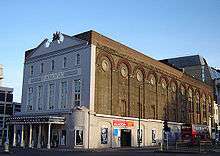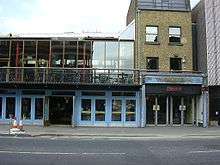The Cut, London
The Cut (formerly New Cut) is a street in London which runs between Waterloo Road in Lambeth and Blackfriars Road in Southwark, approximately parallel to the South Eastern Railway (England). It is perhaps best known as being the location of the well-established Old Vic theatre at the western (Lambeth) end, as well as the more experimental Young Vic theatre halfway along on the other side. Lewisham Southwark College is sited on the south side of The Cut and at the eastern (Southwark) end is Southwark Underground station. Waterloo and Waterloo East stations are also nearby.


Street market
Lower Marsh and The Cut formed the commercial heart of the area from the early 19th century. Henry Mayhew estimated in the 1840s that 300 costermongers attended the market here. He described the scene in " London Labour and the London Poor":
"THE LONDON STREET MARKETS ON A SATURDAY NIGHT.
The street sellers are to be seen in the greatest numbers at the London street markets on a Saturday night. Here, and in the shops immediately adjoining, the working-classes generally purchase their Sunday's dinner; and after pay-time on Saturday night, or early on Sunday morning, the New-cut, and the Brill in particular, is almost impassable.
Indeed, the scene in these parts has more of the character of a fair than a market. There are hundreds of stalls, and every stall has its one or two lights; either it is illuminated by the intense white light of the new self-generating gas-lamp, or else it is brightened up by the red smoky flame of the old-fashioned grease lamp. One man shows off his yellow haddock with a candle stuck in a bundle of firewood ; his neighbour makes a candlestick of a huge turnip, and the tallow gutters over its sides; whilst the boy shouting "Eight a penny, stunning pears!" has rolled his dip in a thick coat of brown paper, that flares away with the candle. Some stalls are crimson with the fire shining through the holes beneath the baked chestnut stove; others have handsome octahedral lamps, while a few have a candle shining through a sieve: these, with the sparkling ground-glass globes of the tea-dealers' shops, and the butchers' gaslights streaming and fluttering in the wind, like flags of flame, pour forth such a flood of light, that at a distance the atmosphere immediately above the spot is as lurid as if the street were on fire.
Then the sights, as you elbow your way through the crowd, are equally multifarious. Here is a stall glittering with new tin sauce-pans; there another, bright with its blue and yellow crockery, and sparkling with white glass. Now you come to a row of old shoes arranged along the pavement; now to a stand of gaudy tea-trays; then to a shop with red handkerchiefs and blue checked shirts, fluttering backwards and forwards, and a counter built up outside on the kerb, behind which are boys beseeching custom. At the door of a tea-shop, with its hundred white globes of light, stands a man delivering bills, thanking the public for past favours, and defying competition. Here, alongside the road, are some half-dozen headless tailors' dummies, dressed in Chesterfields and fustian jackets, each labelled, "Look at the prices," or "Observe the quality." After this is a butcher's shop, crimson and white with meat piled up to the first-floor, in front of which the butcher himself, in his blue coat, walks up and down, sharpening his knife on the steel that hangs to his waist. A little further on stands the clean family, begging; the father of with his head down, as if in shame, and a box of lucifers held forth in his hand—the boys in newly-washed pinafores, and the tidily got-up mother with a child at her breast. This stall is green and white with bunches of turnips—that red with apples, the next yellow with onions, and another purple with pickling cabbages. One minute you pass a man with an umbrella turned inside up and full of prints; next, you hear one with a peepshow of Mazeppa, and Paul Jones the pirate, describing the pictures to the boys looking in at the little round windows. Then is heard the sharp snap of the percussion-cap from the crowd of lads firing at the target for nuts; and the moment afterwards, you see either a black man half-clad in white, and shivering in the cold with tracts in his hand, or else you hear the sounds of music from Frazier's Circus, on the other side of the road, and the man outside the door of the penny concert, beseeching you to " Be in time—be in time!" as Mr. Somebody is just about to sing his favourite song of the Knife Grinder." Such, indeed, is the riot, the struggle, and the scramble for a living, that the confusion and uproar of the New-cut on Saturday night have a bewildering and saddening effect upon the thoughtful mind.
Each salesman tries his utmost to sell his wares, tempting the passers-by with his bargains. The boy with his stock of herbs offers "a double 'andful of fine parsley for a penny;" the man with the donkey-cart filled with turnips has three lads to shout for him to their utmost, with their Ho! ho! hi-i-i! What do you think of this here ? A penny a bunch—hurrah for free trade! Here's your turnips!" Until it is seen and heard, we have no sense of the scramble that is going on throughout London for a living. The same scene takes place at the Brill—the same in Leather-lane—the same in Tottenham-court-road—the same in Whitecross-street; go to whatever corner of the metropolis you please, either on a Saturday night or a Sunday morning, and there is the same shouting and the same struggling to get the penny profit out of the poor man's Sunday's dinner."
The fortunes of the street market changed rapidly with time. In 1851 Mayhew wrote: "Since the above description was written, the New Cut has lost much of its noisy and brilliant glory. In consequence of a New Police regulation, "stands" or "pitches" have been forbidden, and each coster, on a market night, is now obliged, under pain of the lock-up house, to carry his tray, or keep moving with his barrow. The gay stalls have been replaced by deal boards, some sodden With wet fish, others stained purple with blackberries, or brown with walnut-peel; and the bright lamps are almost totally superseded by the dim, guttering candle. Even the pole under the tray or "shallow" is resting on the ground, the policeman on duty is obliged to interfere. The mob of purchasers has diminished one-half; and instead of the road being filled with customers and trucks, the pavement and kerb-stones are scarcely crowded."[1]
The market in the Cut continued until the 1950s, when the street was designated as the B300 thoroughfare between Borough High Street and Westminster Bridge Road; the remaining traders moved to Lower Marsh where some street stalls continue (to 2019), or to new shops rebuilt on the bombed sites.
A boxing gymnasium situated above a pub on The Cut is alleged to be where the modern rules for the sport of boxing were penned. The street is also now home to a range of restaurants, shops and offices.
References
- Vol. 1. The London Street-Folk. London, UK: George Woodfall and Son. 1851. Retrieved 30 September 2013.Volume 1 E-Text. Tufts Digital Library. hdl:10427/53837. External link in
|work=(help)